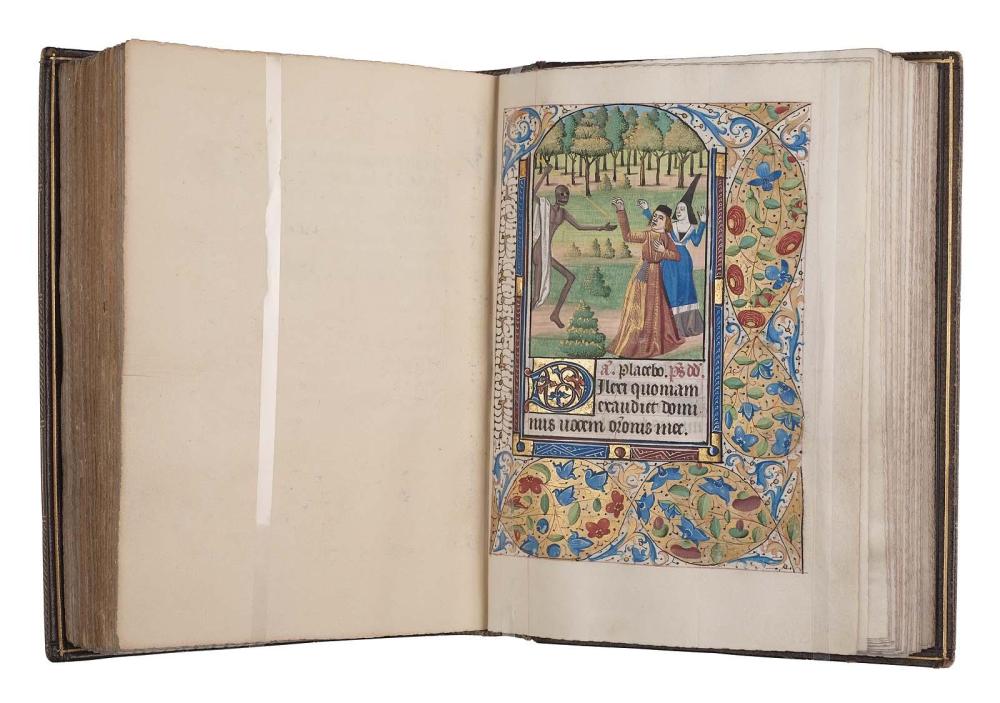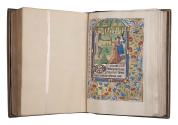Advanced Search
Book of Hours (Possibly for Use of Péronne)
French (Loire Valley, possibly Tours)
Medieval (Gothic)
about 1450–75
Place of Manufacture: Europe, possible Tours, France, Loire Valley
Medium/Technique
Tempera and ink with gold on parchment; bindings of dark olive russian diced leather over boards with gilding
Dimensions
Overall (page dimensions): 18.2 x 13.5 cm (7 3/16 x 5 5/16 in.)
Credit Line
Bequest of Mrs. Arthur Croft—The Gardner Brewer Collection
Accession Number01.6751
NOT ON VIEW
CollectionsEurope
ClassificationsBooks and manuscripts – Manuscripts
DescriptionBook of Hours with 180 folios (ff.) and 11 leaves.
ff. 1 - 12: Calendar
ff. 13 - 19v: Gospel readings
ff. 19v - 23v: Obsecro te (masculine usage)
ff. 23v - 28: O intemerata
f. 28v: [blank]
ff. 29 - 92: Hours of the Virgin (use unidentified, possibly Péronne)
(ff. 29 - 41v: Matins)
(ff. 42 - 54v: Lauds)
(ff. 55 - 61v: Prime)
(ff. 62 - 66v: Terce)
(ff. 67 - 71v: Sext)
(ff. 72 - 76v: None)
(ff. 77 - 85v: Vespers)
(ff. 86 - 92v: Compline)
ff. 93 - 101v: [Hours of the Cross]
ff. 102 - 108v: Hours of the Holy Spirit
ff. 109 - 130v: Penitential Psalms, litany, prayers
ff. 131 - 167: Office of the Dead (one nocturn only, use indeterminable)
ff. 167v - 173v: Les Quinze joyes notre dame [The Fifteen Joys of the Virgin, in French]
ff. 173v - 177: Les sept requestes a notre seigneur [The Seven Requests of Our Lord, in French]
ff. 177 - 178: Memoire des V. festes notre dame/ Ave cuius conceptio…/…et cum ipsa gaudere mereamur in celis. Per christum dominum nostrum Amen.
ff. 178v - 180v: Les vers S. Bernard/ Illumina oculos meos…/…et a morte perpetua liberemur. Per eundem christum dominum nostrum. Amen.
1 column of 15 text lines in Latin and French. Bounding lines in red plummet, full-length to all edges, writings lines in red plummet.
Catchwords in lower right corner of last verso of each quire, mostly trimmed, in bâtarde script. No foliation.
Written in a Gothic bookhand in black ink with red rubrics. 2- to 4-line initials throughout in blue with white filigree highlights with leafy vines in colors on gold background (KLs similar). One-line initials throughout alternating gold filled with red on blue background or gold filled with blue on red background, all with white filigree highlights. Seven ¾-borders of acanthus, flowers, and leaves in colors (for the Gospels of Luke, Matthew, and Mark, Obsecro te, O intemerata, the 15 Joys, and the Fifteen Requests).
Thirteen ¾-page miniatures in arched-topped frame with alternating bar-shaped compartments at sides and bottom of dark red or blue with white filigree and gold squares, ¾ -border of acanthus, flowers, and leaves in colors, some on background of gold and white geometric compartments. Several of these images demonstrate a continuity of planning and theological intention; the four scenes that include the Holy Spirit (aside from the Annunciation) - the Nativity, the Visitation, the Adoration, and the Pentecost - show the Holy Spirit descending further into the scene with each appearance. The golden light is barely seen in the Visitation, becomes more prominent in the Nativity, the source is shown for the first time as an cruciform emblem in the Adoration, and finally in the Pentecost the Holy Spirit takes center stage as a fully formed radiant dove. In addition, the interior church scenes (the Annunciation, the Presentation, and the Pentecost) are not identical settings as they are in many manuscripts, but appear to be three different areas in the same church. Distinctive features include tight fingers, pale faces, cylindrical buildings with conical roofs, and occasional gold-scroll style interiors of gold filigree on a dark red background (see Notes field for descriptions.)
Binding: Nineteenth-century English binding of dark olive russian diced leather over boards, gilt fillets with corner blind and gilt floral stamps. Spine gilt in compartments. By C. Lewis (London), according to dealer's description pasted into inner lower cover, but binding not signed or stamped. Gilt board edges, book block edges gilt and impressed with cross-hatch pattern with floral stamp in each square. Vellum pastedowns and endleaves (two at front and two at back), gilt fillet turn-ins.
Produced in the Loire Valley, possibly Tours, in the third-quarter of the fifteenth century, for the use of a patron in or near Péronne (about 50 miles southeast of Amiens and northwest of Reims) - the calendar includes, in red, the feast of St. Furseus of Péronne (16 Jan.) and two translations (9 Feb. and 17 Sept.), as well as two octaves, an especial veneration of Furseus that would have been centered in or near his relics in Péronne. Furseus is also found in the litany, first among the confessors after the standard group. Also of note in the calendar are Remigius of Reims (13 Jan.), Hupertus (4 Nov., should be 3 Nov.), Fuscianus (11 Dec.), and Nicasius of Reims (14 Dec.). Saints of particular import in Amiens are also included in the calendar, such as Firminus (25 Sept.) and Wulfrannus (15 Oct., a date used particularly in and near Amiens). Armorial bookplate of Gardner Brewer (1806 - 1874) inner front, with motto "Memor et Fidelis."
ff. 1 - 12: Calendar
ff. 13 - 19v: Gospel readings
ff. 19v - 23v: Obsecro te (masculine usage)
ff. 23v - 28: O intemerata
f. 28v: [blank]
ff. 29 - 92: Hours of the Virgin (use unidentified, possibly Péronne)
(ff. 29 - 41v: Matins)
(ff. 42 - 54v: Lauds)
(ff. 55 - 61v: Prime)
(ff. 62 - 66v: Terce)
(ff. 67 - 71v: Sext)
(ff. 72 - 76v: None)
(ff. 77 - 85v: Vespers)
(ff. 86 - 92v: Compline)
ff. 93 - 101v: [Hours of the Cross]
ff. 102 - 108v: Hours of the Holy Spirit
ff. 109 - 130v: Penitential Psalms, litany, prayers
ff. 131 - 167: Office of the Dead (one nocturn only, use indeterminable)
ff. 167v - 173v: Les Quinze joyes notre dame [The Fifteen Joys of the Virgin, in French]
ff. 173v - 177: Les sept requestes a notre seigneur [The Seven Requests of Our Lord, in French]
ff. 177 - 178: Memoire des V. festes notre dame/ Ave cuius conceptio…/…et cum ipsa gaudere mereamur in celis. Per christum dominum nostrum Amen.
ff. 178v - 180v: Les vers S. Bernard/ Illumina oculos meos…/…et a morte perpetua liberemur. Per eundem christum dominum nostrum. Amen.
1 column of 15 text lines in Latin and French. Bounding lines in red plummet, full-length to all edges, writings lines in red plummet.
Catchwords in lower right corner of last verso of each quire, mostly trimmed, in bâtarde script. No foliation.
Written in a Gothic bookhand in black ink with red rubrics. 2- to 4-line initials throughout in blue with white filigree highlights with leafy vines in colors on gold background (KLs similar). One-line initials throughout alternating gold filled with red on blue background or gold filled with blue on red background, all with white filigree highlights. Seven ¾-borders of acanthus, flowers, and leaves in colors (for the Gospels of Luke, Matthew, and Mark, Obsecro te, O intemerata, the 15 Joys, and the Fifteen Requests).
Thirteen ¾-page miniatures in arched-topped frame with alternating bar-shaped compartments at sides and bottom of dark red or blue with white filigree and gold squares, ¾ -border of acanthus, flowers, and leaves in colors, some on background of gold and white geometric compartments. Several of these images demonstrate a continuity of planning and theological intention; the four scenes that include the Holy Spirit (aside from the Annunciation) - the Nativity, the Visitation, the Adoration, and the Pentecost - show the Holy Spirit descending further into the scene with each appearance. The golden light is barely seen in the Visitation, becomes more prominent in the Nativity, the source is shown for the first time as an cruciform emblem in the Adoration, and finally in the Pentecost the Holy Spirit takes center stage as a fully formed radiant dove. In addition, the interior church scenes (the Annunciation, the Presentation, and the Pentecost) are not identical settings as they are in many manuscripts, but appear to be three different areas in the same church. Distinctive features include tight fingers, pale faces, cylindrical buildings with conical roofs, and occasional gold-scroll style interiors of gold filigree on a dark red background (see Notes field for descriptions.)
Binding: Nineteenth-century English binding of dark olive russian diced leather over boards, gilt fillets with corner blind and gilt floral stamps. Spine gilt in compartments. By C. Lewis (London), according to dealer's description pasted into inner lower cover, but binding not signed or stamped. Gilt board edges, book block edges gilt and impressed with cross-hatch pattern with floral stamp in each square. Vellum pastedowns and endleaves (two at front and two at back), gilt fillet turn-ins.
Produced in the Loire Valley, possibly Tours, in the third-quarter of the fifteenth century, for the use of a patron in or near Péronne (about 50 miles southeast of Amiens and northwest of Reims) - the calendar includes, in red, the feast of St. Furseus of Péronne (16 Jan.) and two translations (9 Feb. and 17 Sept.), as well as two octaves, an especial veneration of Furseus that would have been centered in or near his relics in Péronne. Furseus is also found in the litany, first among the confessors after the standard group. Also of note in the calendar are Remigius of Reims (13 Jan.), Hupertus (4 Nov., should be 3 Nov.), Fuscianus (11 Dec.), and Nicasius of Reims (14 Dec.). Saints of particular import in Amiens are also included in the calendar, such as Firminus (25 Sept.) and Wulfrannus (15 Oct., a date used particularly in and near Amiens). Armorial bookplate of Gardner Brewer (1806 - 1874) inner front, with motto "Memor et Fidelis."
ProvenanceUntil 1874, Gardner Brewer (b. 1806 - d. 1874), Boston [see note 1]; by descent to his daughter, Caroline Abigail Brewer (Mrs. Arthur) Croft (d. 1898), Boston; 1901, bequest of Mrs. Arthur Croft to the MFA. (Accession Date: July 1, 1901)
NOTES:
[1] An armorial bookplate of Gardner Brewer, with the motto "Memor et Fidelis," is on the inner front.
NOTES:
[1] An armorial bookplate of Gardner Brewer, with the motto "Memor et Fidelis," is on the inner front.








